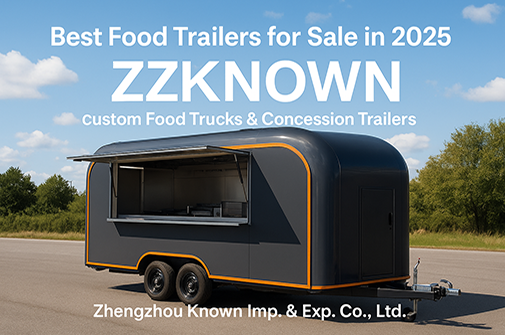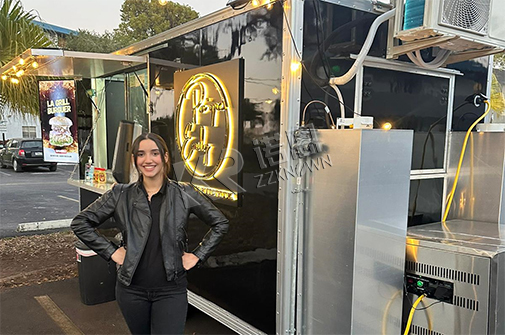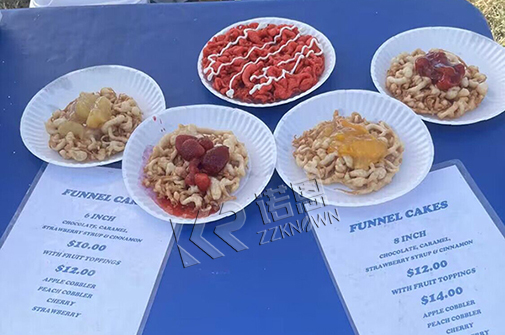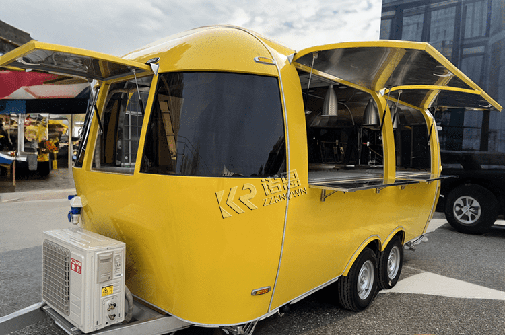The mobile food industry continues its dynamic expansion, presenting a compelling and accessible avenue for entrepreneurial ventures in the culinary world. Within this vibrant sector, the popularity of kebab trailers has surged, fueled by the widespread appeal of kebabs as a convenient, flavorful, and adaptable food choice. This increasing preference for mobile food solutions and the specific allure of kebabs together establish a robust market for specialized kebab trailers. For aspiring and established food entrepreneurs alike, customization represents a vital strategy to achieve distinction within a competitive landscape and to precisely align the mobile kitchen with distinct business objectives and the preferences of the intended customer base. This article will delve into the extensive array of customization possibilities available for kebab trailers, offering valuable perspectives for potential buyers navigating markets across diverse regions, including Europe, the USA, Australia, New Zealand, and the Middle East.
Before embarking on the journey of customizing a kebab trailer, it is paramount to first establish a clear and comprehensive vision for the business. This foundational step involves a thorough evaluation of several critical factors that will ultimately shape the design and functionality of the mobile kitchen.
A fundamental aspect of this initial stage is to identify the specific demographic that the business aims to serve. Understanding the characteristics and preferences of ideal customers, such as students seeking affordable meals, office workers looking for quick lunch options, or attendees at festivals and events desiring convenient snacks, will directly influence the menu offerings. The variety of kebabs to be offered, along with any supplementary menu items, needs careful consideration. The potential to cater to specific dietary needs, such as vegetarian or vegan options, can also broaden the customer base. The menu’s scope will dictate the necessary equipment and the optimal layout of the trailer. Different customer segments exhibit varying tastes and requirements, which must be reflected in the food provided and the operational setup of the mobile unit.
Another crucial consideration is the financial resources allocated for the purchase and customization of the kebab trailer. The total budget will significantly influence the size of the trailer, the quality and sophistication of the equipment, and the extent of customization achievable. The number of staff members intended to operate within the trailer will also impact the required internal space and layout. Smaller trailers, typically ranging from 2 to 4 meters in length, might comfortably accommodate 2-3 individuals, while larger units, extending to 7-8 meters, can provide sufficient workspace for 6-8 people. Furthermore, the anticipated daily or weekly sales volume will influence the selection of equipment, with higher volumes potentially necessitating more robust and larger-capacity appliances. The available financial resources and the intended level of operation will naturally define the boundaries and possibilities for customization.
Compliance with local regulations is a non-negotiable aspect of operating a food business. Thorough research into the specific health and safety regulations applicable in the intended operating areas is essential. This includes understanding requirements related to food handling practices, safe food storage temperatures, and general hygiene standards. Regulations often specify the types of sinks required for handwashing, food preparation, and utensil cleaning, as well as the necessary ventilation and fire suppression systems. Furthermore, it is crucial to identify and secure all the necessary permits and licenses required for mobile food vendors, as these can vary considerably between different regions and municipalities. Failure to adhere to these regulatory standards can result in penalties or the inability to operate the business legally.
The internal configuration and equipment within a kebab trailer are paramount for ensuring efficient workflow and maintaining the quality of the food being served.
Designing an internal layout that facilitates a smooth and logical flow for all operational stages, from initial food preparation to the final serving of the kebab, is crucial for maximizing efficiency and minimizing potential bottlenecks. Careful consideration should be given to the strategic placement of all equipment, designated workstations for different tasks, and accessible storage areas. An effectively designed workspace will streamline operational processes and contribute to a more productive and less physically demanding environment for the staff.
The choice of cooking equipment is a primary determinant of the menu capabilities and the overall efficiency of the kebab trailer. Kebab grills, the centerpiece of the operation, can be either gas-powered or electric, with the selection often based on personal preference, cost considerations, and local regulatory requirements. Gas grills are often favored for the traditional flavor they impart to the kebabs, while electric grills can offer greater convenience and more precise temperature control. Depending on the planned menu, the inclusion of fryers and griddles might be necessary, especially if offering popular side items like fries or grilled halloumi. Other essential appliances to consider include bain-maries for keeping pre-cooked ingredients warm, ovens for baking fresh bread or other menu items, and specialized equipment such as electric sausage cutters if the menu extends beyond traditional kebabs. The selection of cooking equipment should directly align with the intended menu and ensure both the quality and speed of food preparation.
Adequate refrigeration and storage are indispensable for maintaining food safety and effectively managing inventory within a kebab trailer. Selecting refrigerators and freezers of appropriate sizes and types, such as under-counter units or upright models, is crucial for storing ingredients and prepared food items at safe temperatures. The required storage capacity will depend on the volume of ingredients needed and the available space within the trailer. Some operations might benefit from refrigerated display cases to showcase prepared kebabs and other tempting offerings, enhancing visual appeal and potentially increasing impulse purchases. Furthermore, incorporating a variety of storage units, including shelves, cabinets, and drawers, is essential for organizing dry goods, utensils, and packaging materials efficiently. Maximizing vertical space through the installation of wall-mounted shelves can further optimize storage capacity within the often-limited confines of a food trailer.
Maintaining stringent hygiene standards is not only crucial for gaining and retaining customer trust but is also a fundamental requirement for regulatory compliance. Installing the necessary number of sinks, including dedicated sinks for handwashing, food preparation, and utensil washing, is typically mandated by local health codes. Double or even triple sink setups are common in food trailers to meet these requirements. Selecting fresh and wastewater tanks of appropriate capacities is also essential, with tank sizes often customizable to suit specific operational needs. Effective planning for waste management, including the proper disposal of food waste and general trash, is another critical aspect of maintaining hygiene. Designating specific, easily accessible waste receptacles that can be regularly emptied is important for a clean and sanitary working environment.
A reliable and sufficient power supply is fundamental for the uninterrupted operation of all equipment within a kebab trailer. Choosing a generator with an adequate power output to run all electrical appliances simultaneously is a key consideration. It is important to calculate the total wattage requirements of all equipment and select a generator with some additional capacity to avoid overloading. Ensuring an ample number of properly installed electrical outlets throughout the trailer is also essential for powering all the necessary appliances. Some trailers may utilize 400V connections for higher power demands. Considering both single-phase and three-phase electricity options might be necessary depending on the specific equipment being used. Finally, installing sufficient interior lighting is crucial for creating a safe and efficient working environment, with energy-efficient LED lighting being a popular choice for its brightness and low power consumption.
Prioritizing safety within a kebab trailer is paramount for the well-being of staff and for complying with safety regulations. Installing a properly sized extraction hood above the cooking equipment is essential for effectively removing smoke, grease, and cooking odors from the interior of the trailer. The hood should be of a gastro-grade quality for optimal performance. Incorporating readily accessible fire extinguishers of the appropriate type and size is a fundamental safety measure. Depending on local regulations and the specific types of cooking equipment used, more advanced fire suppression systems might be required. Ensuring adequate ventilation and having appropriate fire safety equipment are critical for preventing accidents and maintaining a safe working environment for everyone inside the trailer.
The exterior appearance and features of a kebab trailer are crucial for attracting customers and ensuring the practical functionality of the mobile business.
Kebab trailers are available in a variety of dimensions and configurations, including square, round, and even airstream-style designs. Sizes can range from compact 3-meter units to larger XXL sales trailers. The selection of the appropriate size and type of trailer should be based on a careful assessment of operational needs, budgetary constraints, and the characteristics of the intended vending locations. Factors such as parking restrictions and the amount of space available at chosen sites should be taken into account. Different trailer types, such as standard, luxury, or highly specialized models, offer varying levels of features and finishes. The size and type of trailer chosen will significantly impact its maneuverability, the amount of internal workspace, and the overall aesthetic appeal of the mobile business.
Well-designed serving windows are essential for facilitating efficient and positive interactions with customers. Optimizing the size and placement of these windows can significantly improve the speed and ease of service. Some operators might consider incorporating multiple serving windows to handle customer flow more effectively during peak hours. Features such as easy-glide plexiglass windows can enhance hygiene and provide protection from the elements. Additionally, the inclusion of awnings or canopies above the serving windows can offer valuable shelter for customers from both sun and rain, as well as enhance the trailer’s visibility. Effective serving window design contributes directly to a positive customer experience and streamlined operational efficiency.
The exterior of a kebab trailer serves as a mobile billboard for the business, making strong visual branding a critical element for attracting customers. Utilizing vehicle wraps with eye-catching designs that prominently feature the brand logo is a highly effective way to create a memorable and professional image. Custom wraps can transform a plain trailer into a distinctive and recognizable brand asset, effectively communicating the business’s identity and message. The choice of paint color for the trailer should also align with the overall brand identity, with bright and inviting colors often being preferred. Furthermore, strategically placed signage and exterior lighting can significantly enhance the trailer’s visibility, particularly during evening hours, making it stand out and attracting more attention. LED signs and well-positioned floodlights can dramatically improve the trailer's presence and appeal.
Given the mobile nature of the business, ensuring the trailer is easy to transport and set up is paramount. Considerations such as the trailer’s towing capacity and its features, including the number of axles and the type of suspension system, are important. Options for single-axle or double-axle trailers are available, each offering different handling characteristics. Ensuring the trailer is easy to maneuver and park in various locations is also crucial, taking into account its overall weight and dimensions. Features like a wind-down jockey wheel can greatly simplify the process of hitching and unhitching the trailer. Many European trailers also boast features like 100 km/h approval, indicating their roadworthiness and suitability for highway travel. Practical external features contribute significantly to the ease and efficiency of operating a mobile food business.
Beyond the core branding and mobility features, several additional external elements can enhance the functionality and customer comfort associated with a kebab trailer. Exterior lighting, such as strategically placed floodlights, can improve visibility and create a welcoming ambiance around the trailer. Providing a designated customer waiting area or incorporating fold-out counters can add convenience for patrons. Ensuring easy access to the trailer through the inclusion of sturdy steps or ramps, potentially considering accessibility for all customers, is also an important detail. These functional exterior elements contribute to a more efficient operation and a more positive overall experience for customers.
Understanding regional preferences and current market trends is essential for making informed decisions during the customization process of a kebab trailer. Analyzing popular online searches related to "kebab trailer for sale" in different geographical areas can provide valuable insights into the specific features and considerations that are most relevant to potential buyers in those regions.
In the European market, there is often a strong emphasis on the robustness of the trailer's construction and strict adherence to local regulations. Features such as 100 km/h approval, as seen in some listings , indicate a focus on roadworthiness and compliance with European traffic laws. Additionally, certain integrated features like microwave and grill functions, electric sausage cutters, and hot water boilers appear to be common inclusions in European kebab trailer designs. These trends suggest that those looking to operate a kebab trailer in Europe should prioritize build quality and ensure their trailer is equipped to meet local regulatory standards and the culinary preferences of the European market.
The United States market for kebab trailers presents a mix of both new and pre-owned options, with a general focus on providing fully equipped mobile kitchens. Certain equipment, such as large propane tanks, commercial-grade fryers, and sandwich or salad preparation tables, are frequently observed in US-based food trailers. This suggests that potential buyers in the USA might want to consider a comprehensive range of cooking and preparation equipment to cater to a diverse menu that extends beyond just kebabs.
The Australian market places a significant emphasis on adherence to local standards and compliance with government health regulations. Dedicated kebab trailer models that come equipped with built-in kebab machines are readily available. Features like dual gas systems and electrical wiring that meets Australian standards are also important considerations. Furthermore, financing options are often highlighted in listings for kebab trailers in Australia , indicating that affordability and ease of acquisition are key factors for buyers in this region. The prevalence of ready-to-operate kebab trailer packages suggests a demand for solutions that allow entrepreneurs to start their business quickly and efficiently.
In New Zealand, compliance with local City Council requirements is a primary concern for those operating food trailers. Customization and design services are widely offered, suggesting that buyers in this market often seek tailored solutions to meet their specific needs and local regulations. The availability of "New Zealand Standard" kebab trailers further underscores the importance of adhering to local regulations and preferences. The New Zealand market appears to value both regulatory compliance and the opportunity to create bespoke mobile food businesses through customization.
While the provided research material does not explicitly detail specific trends for "kebab trailer for sale Middle East", some general considerations can be inferred. Given the region's climate, designs that incorporate effective ventilation and cooling solutions might be particularly important. Additionally, culturally specific cooking equipment, such as larger vertical rotisseries suitable for preparing traditional shawarma or gyros, could be a key customization requirement. Adherence to local customs and regulations regarding food preparation and service would also be paramount for success in this market. While direct data is limited, it is reasonable to anticipate that customization needs in the Middle East would be influenced by both the climate and the specific culinary traditions of the region.
The following table provides a concise summary of essential internal and external customization options to consider when planning your kebab trailer.
| Feature Category | Essential Options | Considerations |
|---|---|---|
| Internal | Kebab Grill (Gas or Electric) | Size, capacity, fuel source, local regulations |
| Stainless Steel Worktops | Durability, hygiene | |
| Refrigeration (Fridge and/or Freezer) | Size, capacity based on menu and storage needs | |
| Handwashing Sink with Hot and Cold Water | Compliance with health codes, tank sizes | |
| Food Prep Sink | Compliance with health codes, size | |
| Adequate Electrical Outlets and Wiring | Power requirements of equipment, safety standards | |
| Interior Lighting (LED Recommended) | Visibility, safety, energy efficiency | |
| Ventilation (Extraction Hood - Gastro Grade Recommended) | Removal of smoke, grease, and odors, compliance with regulations | |
| Fire Extinguisher (Appropriate Type and Size) | Compliance with safety regulations | |
| External | Serving Window with Awning/Cover | Customer access, weather protection |
| Durable Trailer Body (Stainless Steel or Aluminum) | Longevity, weather resistance | |
| Secure Entry Door with Lock | Security, ease of access | |
| Road-Legal Lights and Signals | Compliance with traffic laws | |
| Branding (Wrap or Paint with Logo) | Attractiveness, brand recognition | |
| Google Hot Topics Focus | Compliance with European/US/Australian/NZ Standards (as applicable) | Ensures legal operation in the target market |
| Region-Specific Equipment (e.g., LPG for Australia, specific electrical standards) | Meets local operational needs and safety requirements |
Beyond the fundamental customization options, several additional enhancements can be considered to elevate the functionality and appeal of a kebab trailer. Incorporating advanced cooking technologies, such as self-cleaning grills or high-efficiency fryers, can improve operational efficiency and reduce maintenance. Enhanced storage solutions, like convenient pull-out drawers or specialized organizers , can further optimize the use of limited space. Premium finishes and aesthetic upgrades, such as custom lighting fixtures or high-quality countertops , can enhance the overall look and feel of the trailer. Integrating modern technology, such as point-of-sale (POS) systems for efficient order taking and payment processing, can streamline transactions and improve customer service. Even adding customer entertainment systems, like built-in speakers for background music or screens for displaying menus or promotions, can contribute to a more engaging customer experience.
A thorough understanding of the specific health and safety regulations in the intended operating locations is absolutely essential. Common requirements often include the provision of proper handwashing facilities with both hot and cold running water, adequate ventilation to remove cooking fumes, appropriate fire suppression systems, and adherence to strict food storage guidelines. It is also crucial to identify and obtain all the necessary permits and licenses required to operate a mobile food business legally, as these can vary significantly depending on the specific region and local municipality. Consulting with legal professionals specializing in the food service industry can help ensure full compliance with all applicable laws and regulations.
Choosing a reputable and experienced manufacturer or dealer is a critical step in the kebab trailer customization process. It is advisable to seek out suppliers with positive customer reviews and a demonstrated history of building high-quality food trailers. Potential buyers should inquire about the supplier’s specific experience with customizing kebab trailers and their ability to meet unique design and equipment requirements. Asking about the types of materials used in the trailer’s construction and the warranty offered on both the trailer itself and any included equipment is also important. Obtaining detailed quotes from multiple suppliers and carefully comparing the options before making a final decision is a prudent approach. Finally, considering suppliers who offer design services, such as providing 2D or 3D renderings of the customized trailer, can be invaluable in visualizing the final product and ensuring it meets all expectations.
With a comprehensive understanding of the diverse customization options available for kebab trailers, the next logical step is to initiate contact with reputable manufacturers and dealers. Potential buyers are encouraged to reach out to suppliers to discuss their specific needs, business vision, and desired customization features. Requesting personalized consultations and detailed quotes for the envisioned customized trailer is a crucial step in the purchasing process. Don't hesitate to ask suppliers detailed questions about their experience, the quality of materials they use, and the after-sales support they provide. Many suppliers offer convenient online contact forms to facilitate these initial inquiries.
Customizing a kebab trailer represents a significant investment that holds the potential to directly influence the success of a mobile food business. By thoughtfully considering the target market, menu offerings, budgetary constraints, and all applicable local regulations, entrepreneurs can create a mobile kitchen that perfectly aligns with their specific needs and effectively distinguishes itself within a competitive market. Leveraging the extensive range of customization options available and establishing a strong partnership with a reliable supplier are key factors that will ultimately pave the way for a thriving and successful kebab business on wheels.




